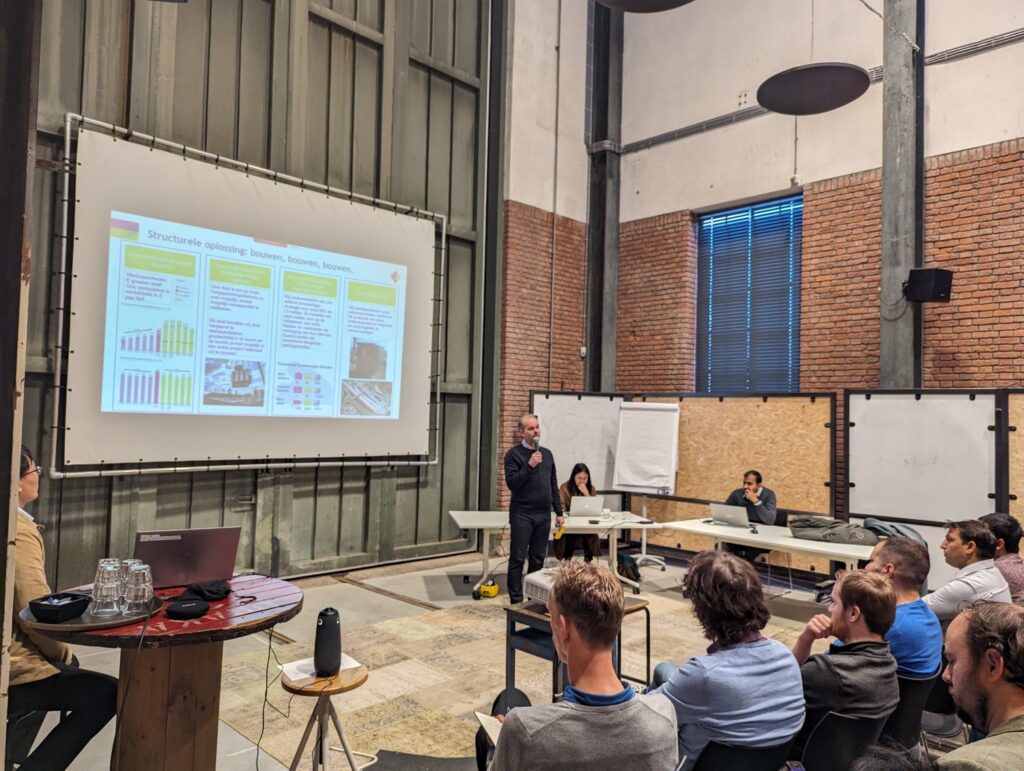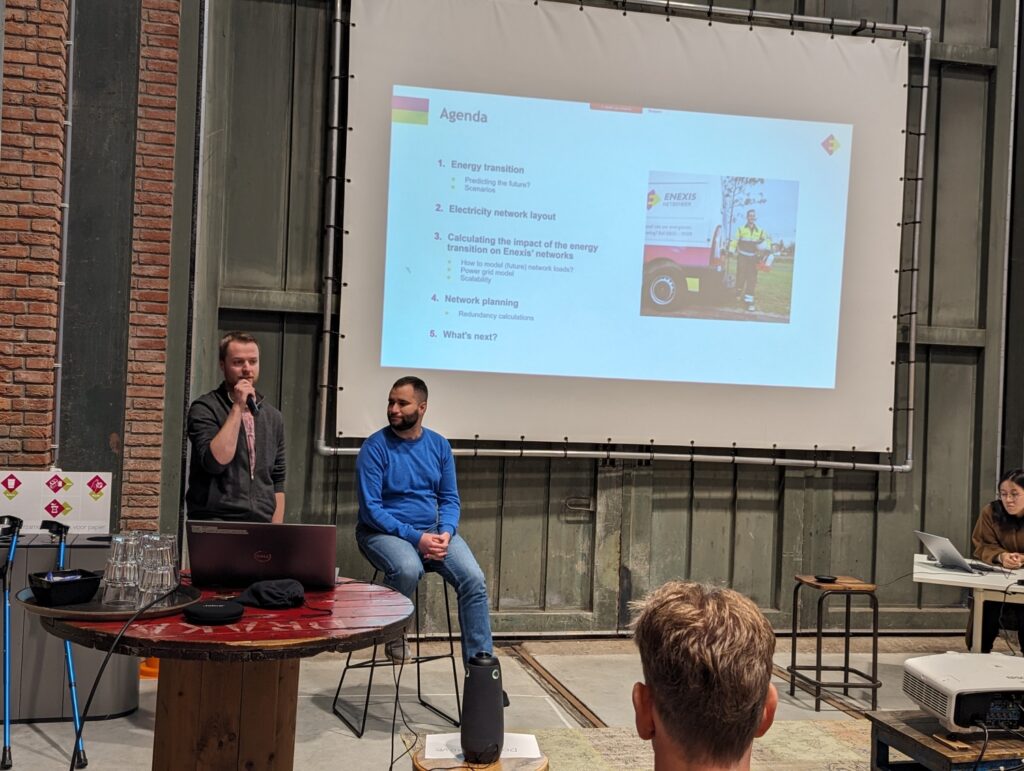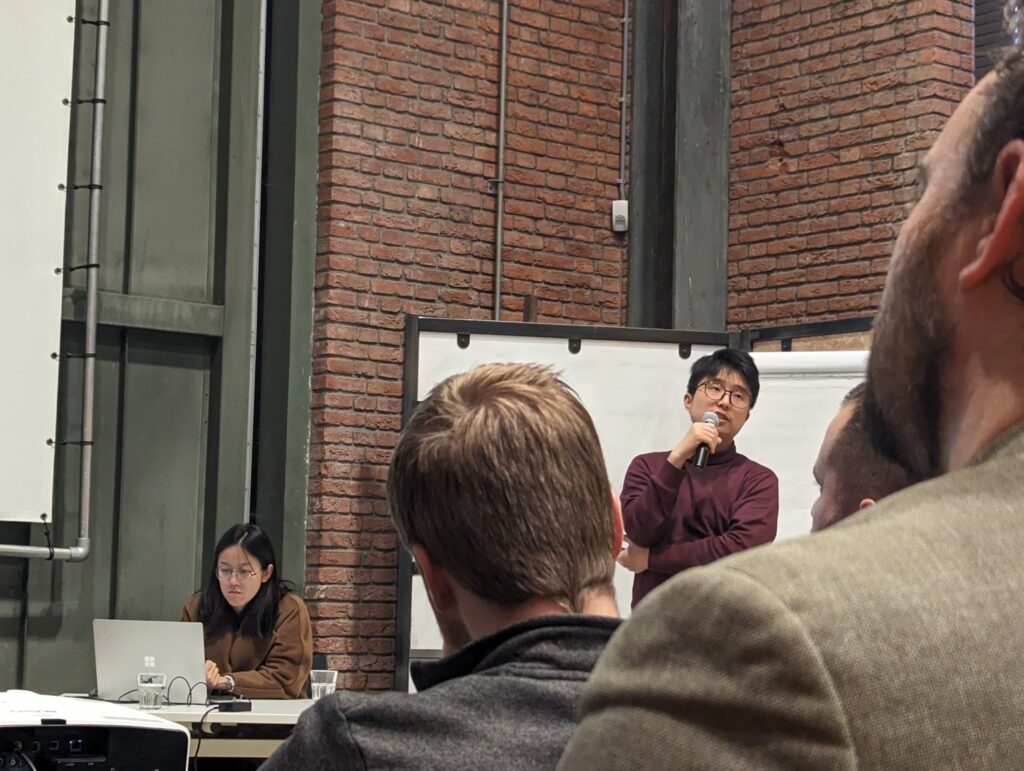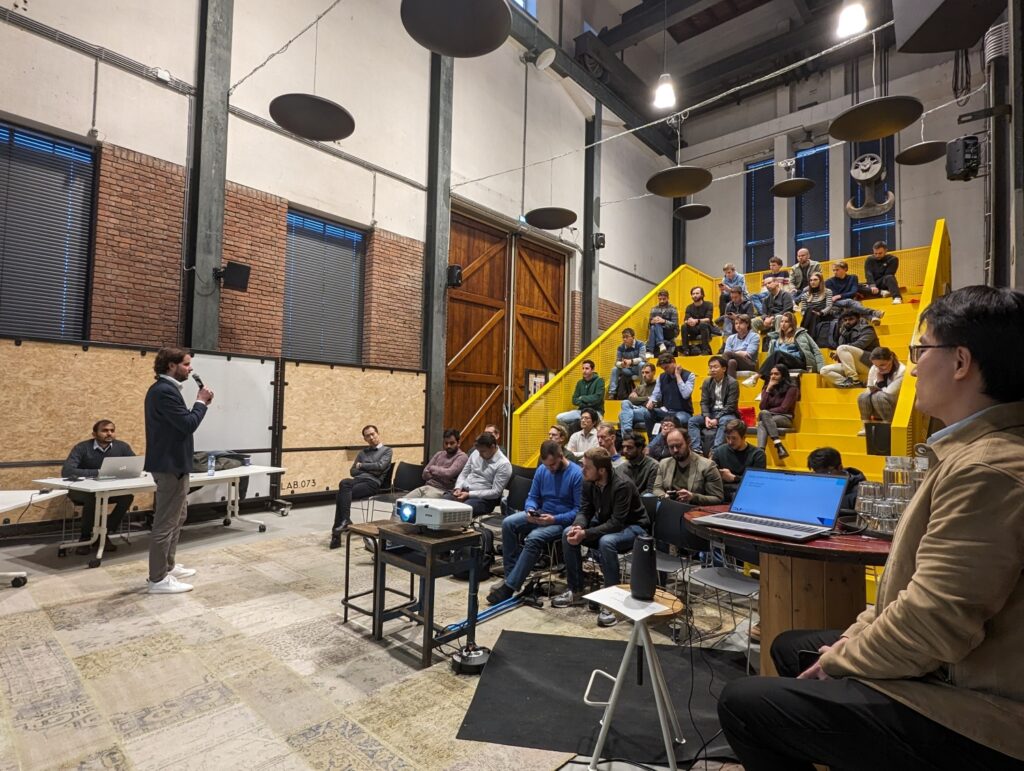Recap of the 4th Power Grid Model Meet-up
By Ben van ‘t Ende
The 4th Power Grid Model Meet-up took place on December 7, 2023. The meet-up was hosted by Enexis in Den Bosch. Enexis is one of the three large Dutch distribution system operators (DSO).
The event was appropriately held in an old substation building with rail tracks still visible where the transformers once where hauled in. The 4th Power Grid Model meet-up had a record-breaking 70+ attendees of which 40+ were there in person. A recap of the day follows, and the full video recording can be viewed at the bottom of this post.
Tony Xiang, chair of the Power Grid Model steering committee, welcomed everyone to the 4th Power Grid Model meet-up and kicked of the day.
Agenda
- Welcome Address: Enexis Digitization and Open Source (Alexander Verweij, manager CIO office, Enexis )
- Predicting Future Network Congestion Arising from the Energy Transition using the Power Grid Model (Joni Hermans & Kenneth Ruys, Enexis)
- Fairness-incorporated Online Feedback Optimization for Real-time Distribution Grid Management (Sen Zhan, TU Eindhoven)
- Highlights Q3/Q4 2023 + Community announcements + brainstorm/planning (Peter Salemink, development lead of PGM maintainers)
Welcome Address on Enexis Digitization and Open Source
 Alexander Verweij, Manager of the CIO Office at Enexis, delivered a comprehensive talk outlining the challenges faced by Enexis in managing network congestion. Verweij drew a comparison between the complexities of handling network congestion and the challenges encountered in road traffic, stressing the significant impact congestion has on electricity distribution.
Alexander Verweij, Manager of the CIO Office at Enexis, delivered a comprehensive talk outlining the challenges faced by Enexis in managing network congestion. Verweij drew a comparison between the complexities of handling network congestion and the challenges encountered in road traffic, stressing the significant impact congestion has on electricity distribution.
Throughout the address, Verweij emphasized the necessity of predicting and managing congestion within Enexis’s networks, particularly considering the growing demand for electricity due to factors like larger companies transitioning from gas to electricity. He underscored the critical need for collaboration, a notion that was previously considered unthinkable in the industry just a few years ago.
Verweij also highlighted the establishment of an open source program office, at the beginning of 2024, mirroring the initiative taken by Alliander. He reiterated the importance of collaboration and shared solutions within the energy sector, emphasizing Enexis’ commitment to open source practices. The talk delved into the challenges posed by network congestion, the unpredictability of energy consumption, and the necessity for collaborative agreements among companies to manage congestion effectively.
One of the key points in Verweij’s address was the expression, “This kind of cooperation was unthinkable 2–3 years ago.” This statement underscored the transformation in the industry’s mindset towards collaboration and open source initiatives. Verweij further discussed Enexis’ efforts to anticipate, address, and optimize their infrastructure and operations through initiatives like open source development. He emphasized the company’s investment in creating open source solutions, fostering collaboration, and ensuring safety across high-voltage environments.
Additionally, Verweij addressed uncertainties surrounding regulatory changes, compliance issues, and the evolving nature of business demands over time. The overarching message centered on the necessity for collaborative efforts, open source solutions, and proactive measures to tackle network congestion in the energy sector. Verweij highlighted the importance of adapting to changes, fostering collaboration, and leveraging open source practices to address the challenges posed by the evolving energy landscape.
Predicting Future Network Congestion Arising from the Energy Transition using Power Grid Model
 Joni Hermans and Kenneth Ruys from Enexis discussed the prediction of future network congestion resulting from the energy transition using Power Grid Model. The discussion covered various challenges, strategies, and modeling techniques employed to anticipate and manage congestion in electricity networks due to factors like solar panels, heat pumps, and other energy consumption changes.
Joni Hermans and Kenneth Ruys from Enexis discussed the prediction of future network congestion resulting from the energy transition using Power Grid Model. The discussion covered various challenges, strategies, and modeling techniques employed to anticipate and manage congestion in electricity networks due to factors like solar panels, heat pumps, and other energy consumption changes.
The conversation detailed efforts to model these changes, generate estimates, and simulate scenarios for assessing network impacts. It emphasized the significance of estimating future energy consumption patterns and uncertainties, highlighting the need for cloud-based simulations, storage, and computation. Moreover, they mentioned the importance of considering different scenarios, investments, and long-term planning when addressing network congestion issues.
Key Questions Addressed in the Discussion:
- Are the estimations being compared with real-world data to ensure accuracy?
- How do you manage different scenarios and uncertainties in investment decisions?
- Do you focus on individual households or distribution levels while modelling future energy consumption?
- What computational shortcuts or statistical techniques are used in these simulations?
- How do you deal with changes in the energy landscape and unexpected events affecting model predictions?
- What measures are taken to ensure the reliability and effectiveness of the implemented solutions?
- How crucial is the ability to react promptly to prevent network congestion?
These questions encapsulate the focus areas and concerns highlighted during the discussion regarding forecasting network congestion in the context of the ongoing energy transition.
Fairness-Incorporated Online Feedback Optimization for Real-Time Distribution Grid Management
 Sen Zhan of the Technical University of Eindhoven presented a novel approach to managing distribution grids in real-time by incorporating fairness considerations into online feedback optimization techniques. The core of the discussion revolved around the challenges faced in distribution grids, including issues with congestion, loading, and voltage problems, especially at the beginning and end of feeders and around transformers.
Sen Zhan of the Technical University of Eindhoven presented a novel approach to managing distribution grids in real-time by incorporating fairness considerations into online feedback optimization techniques. The core of the discussion revolved around the challenges faced in distribution grids, including issues with congestion, loading, and voltage problems, especially at the beginning and end of feeders and around transformers.
The conventional offline automation process used models to predict and control grid behavior. However, Sen Zhan introduced an online feedback optimization approach that doesn’t rely on historical data, but rather constantly updates based on real-time measurements. This approach enables the system to respond dynamically to changing conditions, enhancing grid management efficiency.
The concept draws an analogy to driving a car, where adjustments in speed and acceleration are made based on immediate feedback without needing a predetermined model. Similarly, this new approach adapts its control actions based on real-time data, leading to faster and more accurate responses to grid conditions.
Fairness was introduced as a crucial factor in grid management. By ensuring fairness in the distribution of power among various nodes, Sen Zhan demonstrated that it’s possible to mitigate issues such as uneven power distribution, thereby improving grid stability and reliability. The presentation highlighted case studies and simulations illustrating how the proposed approach significantly improved fairness in power generation distribution, reducing disparities among different grid nodes.
The methodology presented emphasizes decentralized but scalable algorithms that dynamically adjust power generation settings based on real-time feedback. This approach, while efficient, does require sophisticated technology and communication infrastructure to relay information effectively and continuously update control settings.
The Q&A session delved into technical aspects, discussing the impact of losses on voltage calculations, the system’s robustness to changes, and the sensitivity of the model to various parameters. There were also discussions on the scalability of the algorithm and its adaptability to different grid topologies.
In conclusion, Sen Zhan’s presentation showcased how integrating fairness considerations into online feedback optimization techniques can significantly enhance real-time distribution grid management. By dynamically adjusting power generation based on real-time measurements and ensuring fairness in distribution, this approach leads to improved stability, reliability, and efficiency in grid operations.
Power Grid Model Community Participation and Highlights from Q3/Q4 2023
 Peter Salemink, development lead of the Power Grid Model maintainers, began by emphasizing community involvement in the development cycle. He highlighted the significance of community feedback and engagement in shaping the future direction of the project.
Peter Salemink, development lead of the Power Grid Model maintainers, began by emphasizing community involvement in the development cycle. He highlighted the significance of community feedback and engagement in shaping the future direction of the project.
Key Highlights:
- Community-Driven Development Cycle: Salemink stressed the importance of the community’s active involvement in shaping the development cycle, with meetings every six months to gather feedback and feature requests.
- Recent Releases: Detailed two major releases – version 1.5 with short circuit calculations and a new serialization method in the subsequent release.
- Community Input and Feedback: He highlighted the importance of community-driven feedback, feature improvements, and bug fixes, emphasizing ongoing collaboration with researchers.
- Achievements and Milestones: Celebrated achievements such as reaching a milestone of 1.1 million downloads, including automatic downloads like CI, and discussed advancements in methodologies.
- Upcoming Workshops and Support: Salemink invited participation in upcoming workshops and stressed the need for ongoing support from the community, especially concerning long-term strategies and dropping support for older versions.
- Decision-Making and Feature Requests: Encouraged the community to actively participate in decision-making for the project’s future, involving voting on support for different distributions and suggesting features.
- Project Contributions: Salemink reiterated the project’s open source nature and encouraged both users and programmers to contribute by submitting bug reports, feature requests, and validation cases.
- Future Collaboration: Emphasized the importance of continued collaboration, showcasing the roadmap, the discussion board for new ideas, and inviting users to contribute even without programming skills.
Overall, Salemink’s presentation focused on community-driven development, milestones achieved, ongoing enhancements, and the active involvement of users and programmers in shaping the future direction of the Power Grid Model.